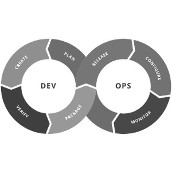When dealing with Kubernetes, backing up an application's data is not as straightforward as when the application is installed directly on your system. Due to its design, Kubernetes orchestrates applications to make them resilient by horizontally scaling them as needed and restarting them upon failure. This often results in applications being started or restarted on different worker nodes in an unpredictable manner.
Moreover, it is often not possible to attach a container for running the backup process to an already running pod. Given these factors, it is clear that backing up applications on Kubernetes introduces additional challenges. Kubernetes Backup - perform Gitea backup on S3 with MinIO shows how to run backups of Kubernets workloads, providing as example how to backup Gitea on S3.
Category: Dev-Ops Tools

Dev-Ops is a methodology aimed to speed-up application development and release aimed at promoting
- fast development methodologies – Development teams
- fast quality assurance methodologies – QA teams
- fast deployment methodologies – System Operators teams
- iteration and continuous feedback – Project Management teams
The aim is to achieve a faster time to market.
DevOps inherits Agile methods such as SCRUM Project Management, but it is more focused on the tools necessary to achieve the goal. It is also possible to involve the Security delegating some rights to the other teams: this approach is called DevSecOps.
These tools Devops brings with it were previously confined into the development field only, such as Source Code Management tools like GIT, branching models such as GitFlow, Continuous Integration and Continuous Delivery tools such as Jenkins or Drone, schedulers such ad dKron, scanners for code quality and compliance such as SonarQube.
This means that professional of every fields, even system engineers and administrators, should have an understanding of these tools and models.
As we saw in the Vagrant - installing and operating post, Vagrant provides a convenient way for automating the setup, configuration and management of virtual machines, enabling reproducible and consistent development environments.
In that post, we also had an overview of how to create a Vagrantbox from scratch for the Parallels provider. We then digged further the process of creating Vagrant boxes from scratch in the Create Oracle Linux 10 aarch64 Vagrantbox for UTM post, where we generated a full featured Vagrant box for ARM64 using the UTM provider.
The missing part to complete your Vagrant skill sets is the creation of Vagrant Boxes Repositories, grouping them into a Vagratn Box Catalog and publish them on an HTTP server, so to make them available to other users.
Vagrant Box Catalog And Vagrant Box Repository Tutorial explains how to pack mutliple Vagrant boxes into a box repositotory and publish it on an HTTP server.
On Apple Macs with Silicon processors, UTM is one of the best free virtualization options available, offering solid performance for ARM-based virtual machines.
As we saw in the Vagrant - installing and operationg post, Vagrant provides a convenient way for automating the setup, configuration, and management of virtual machines, enabling reproducible and consistent development environments.
Sadly, when dealing with Vagrant, there are only a few prebuilt Vagrant boxes supporting the UTM provider, which limits its out-of-the-box usability. Create ARM64 VagrantBox for Oracle Linux on UTM arch64 from Scratch shows how to create an aarch64 Oracle Linux 10 Vagrant box supporting the UTM ARM provider, making it easier to deploy and manage Linux VMs on Apple Silicon.
The Python Smtplib Tutorial - howto send HTML EMAIL with Python is explains how to send HTML emails using SMTP, including auth, SMTP with TLS and SMTPS.
After introducing Python smtplib, the post provides an hands-on example showing how to add HTML email notification to an existing scirpt. The provided code supports every kind of SMTP connection - SMTP, SMTP with startTLS and SMTPS.
This post completes the trilogy we started with the JINJA2 With Python Tutorial JINJA Ansible HowTo and Python Argparse Tutorial - Argparse HowTo posts.
JINJA2 is a powerful yet easy to use templating engine that enables easily generating documents on the fly blending one or more objects with a template.
Since the syntax is heavily inspired by Django and Python, JINJA2 is not only commonly used inside Python scripts: it is very often exploited by Ansible, for example when generating configuration files on the fly.
In "JINJA2 With Python Tutorial JINJA Ansible Howto" post we will learn all the must know about JINJA2, and experiment with it by writing a real-life JINJA2 template file, rendering it by merging it with a JSON document using a custom Python script and an Ansible playbook.
When using Kubernetes, it is mandatory to collect performance metrics so as to be able to plot them into meaningful graphs (a must-have during troubleshooting), visualize alerts in dashboards and get email notification of critical events. The best practice is to deploy Prometheus, Grafana and Alertmanager.
In the "Kubernetes Prometheus And Grafana With kube-prometheus-stack" post we see how to easily deploy and setup these three amazing components to setup a full featured alerting and performance monitoring solution.
The post also shows how to deploy additional Grafana Dashboards and how to deploy custom Prometheus rules to trigger application specific alerts.